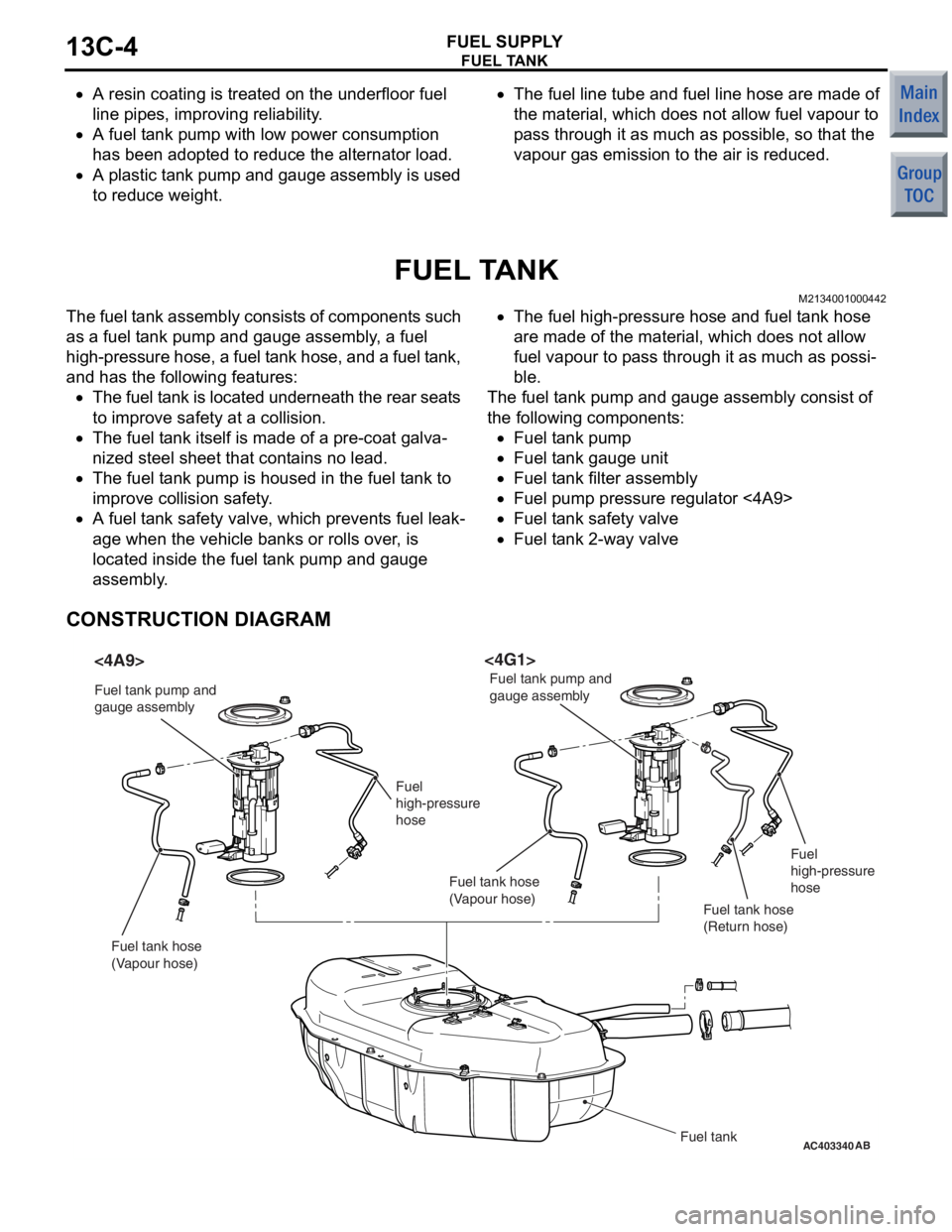2006 MITSUBISHI COLT fuel consumption
[x] Cancel search: fuel consumptionPage 26 of 364

GENERAL INFORMATION
HEATER, AIR CONDITIONER AND VENTILATION55-2
GENERAL INFORMATION
M2551000100759
For the heater and A/C system, the heater, the
blower and the cooling unit are integrated as one unit
to reduce weight and size. For A/C system, the man
-
ual A/C has been adopted.
FEATURES
IMPROVEMENTS IN COMFORT
•Adoption of low noise, large air volume heater
and A/C system
•Adoption of smaller air intake box for larger pas-
senger leg space.
•Optimising the areas of the outside air induction
hole and the air outlet improves ventilation per
-
formance as well as the quietness of the room
•Adoption of clean air filter with deodorant function
for cleaner air in the compartment.
IMPROVEMENTS IN OPERATION
PERFORMANCE
•Inside/outside air selection switch has been
changed to a pushbutton switch.
•Improved operation ability by the enlarged tab on
the dial knob
•Air amount and temperature only are controlled
automatically for easier operation.
RELIABLE VISUAL FIELD
(IMPROVEMENT IN SAFETY)
•Current type defroster nozzle has been adopted
to improve defogging performance (Shortens
windshield fogging time).
•Defroster vents have been integrated to secure
better defogging pattern.
•Black coin drop prevention ribs are used on the
defroster to prevent its reflection on the wind
-
shield, providing sufficient field of vision for safety
IMPROVEMENTS IN FUEL ECONOMY
•Wider condenser area reduces load to the A/C
and improves fuel consumption.
•Energy conservation control using outside air
temperature sensor is adopted for vehicles with
manual A/C as well.
•A small-size, highly-efficient compressor has
been adopted.
•Simpler wiring and weight reduction are achieved
by installation of CAN communication system
GLOBAL ENVIRONMENT PROTECTION
Adoption of HFC134a for refrigerant.
IMPROVEMENTS IN SERVICE QUALITY
•Reduction of refrigerant gas leakage and
improvement in serviceability by incorporating
condenser and receiver
•The layout of refrigerant line for better workability
is adopted.
RESPONSIBILITY IMPROVEMENT
Reliable information transmission is achieved by
connecting A/C-ECU and each ECU via CAN com
-
munication.
Page 32 of 364

A/C-ECU
HEATER, AIR CONDITIONER AND VENTILATION55-8
A/C-ECU
M2551001200179
CONTROL SYSTEM
The manual and automatic A/Cs have the following
control functions.
ControlManual A/CAutomatic A/C
Automatic wind temperature change controlApplicableApplicable
Automatic outside/inside air selection controlApplicableApplicable
Idle-up controlApplicableApplicable
Cooling fun load controlApplicableApplicable
Cooling controlApplicableApplicable
Detection control for refrigerant leaksApplicableApplicable
MAX A/C controlNot applicableApplicable
Estimation control for compressor torqueApplicableApplicable
Defroster linked controlNot applicableApplicable
AUTOMATIC CHANGE CONTROL OF
BLOW WIND TEMPERATURE
(COMPRESSOR
ENERGY-CONSERVATION CONTROL)
Optimum ON/OFF control of the compressor is
achieved according to the outside/inside air mode,
air temperature (air temperature sensor), and insula
-
tion.
OUTSIDE/INSIDE AIR AUTO SWITCHING
CONTROL
When the A/C is turned on in high ambient tempera-
ture, the recirculation function is automatically acti-
vated to cool down the passenger compartment and
improve fuel consumption.
COOLING FUN LOAD CONTROL
Depending on the A/C load, the cooling fan cycle
time is controlled and the exterior noise in the inter
-
mediary stage is decreased. Also, the load of the
alternator is decreased to improve the fuel economy.
COOLING CONTROL
If air temperature is high, the CVT rotates at a high
speed to prevent deterioration in cooling perform
-
ance.
DETECTION CONTROL FOR
REFRIGERANT LEAKS
When it is judged from the air temperature (air tem-
perature sensor) and the refrigerant pressure (A/C
pressure sensor) that the refrigerant amount is the
specified value or less, or the refrigerant pressure is
abnormal, the compressor is forced to be cut off to
protect the A/C system.
MAX A/C CONTROL
When MAX COOL position is set, automatically the
mode is changed to the inside air mode before the
A/C is turned ON, thereby facilitating the operation
for obtaining maximum cooling performance.
ESTIMATION CONTROL FOR
COMPRESSOR TORQUE
Communication between the engine⋅CVT-ECU and
A/C-ECU is made to control the engine according to
the compressor torque for higher drivability and
reduction in fuel consumption.
FORCIBLE DEFROSTER CONTROL
When the defroster vents are selected, the A/C is
automatically turned ON. At this time, the out
-
side/inside air selection damper is operated to the
fresh-air position to defrost the windshield glass
quickly.
Page 235 of 364

GENERAL INFORMATION
POWER STEERING37-2
GENERAL INFORMATION
M2370000100851
Electric power steering system has been adopted for
all models in order to ensure an optimised steering
feeling.
FEATURES
•Improved fuel consumption by reduction of
engine load, and weight saving by decrease of
the number of parts have been achieved with the
introduction of the electric power steering system.
•3-spoke type steering wheel integrated with an
SRS airbag has been adopted.
•Impact-absorbing mechanism and tilt steering
mechanism have been adopted.
SPECIFICATIONS
ItemSpecifications
Vehicles with
14-inch wheelsVehicles with
15-inch wheelsVehicles with
16-inch wheels
Steering wheelTy p e3-spoke type
Outside diameter mm370
Maximum number of turns3.43.22.6
Steering columnColumn mechanismShock absorbing mechanism and tilt steering
mechanism
Power steering typeElectric powered type
Steering gearTy p eRack and pinion
Stroke ratio (Rack
stroke/Steering wheel
maximum turning radius)44.1550.46
Rack stroke mm150143130
Steering angleInner wheel41 ° 40’39 ° 00’34 ° 10’
Outer wheel35 ° 30’33 ° 40’30 ° 00’
Page 340 of 364

FUEL TANK
FUEL SUPPLY13C-4
•A resin coating is treated on the underfloor fuel
line pipes, improving reliability.
•A fuel tank pump with low power consumption
has been adopted to reduce the alternator load.
•A plastic tank pump and gauge assembly is used
to reduce weight.
•The fuel line tube and fuel line hose are made of
the material, which does not allow fuel vapour to
pass through it as much as possible, so that the
vapour gas emission to the air is reduced.
FUEL TANK
M2134001000442
The fuel tank assembly consists of components such
as a fuel tank pump and gauge assembly, a fuel
high-pressure hose, a fuel tank hose, and a fuel tank,
and has the following features:
•The fuel tank is located underneath the rear seats
to improve safety at a collision.
•The fuel tank itself is made of a pre-coat galva-
nized steel sheet that contains no lead.
•The fuel tank pump is housed in the fuel tank to
improve collision safety.
•A fuel tank safety valve, which prevents fuel leak-
age when the vehicle banks or rolls over, is
located inside the fuel tank pump and gauge
assembly.
•The fuel high-pressure hose and fuel tank hose
are made of the material, which does not allow
fuel vapour to pass through it as much as possi
-
ble.
The fuel tank pump and gauge assembly consist of
the following components:
•Fuel tank pump
•Fuel tank gauge unit
•Fuel tank filter assembly
•Fuel pump pressure regulator <4A9>
•Fuel tank safety valve
•Fuel tank 2-way valve
CONSTRUCTION DIAGRAM
AC403340AB
<4A9><4G1>
Fuel tank
Fuel tank pump and
gauge assembly
Fuel tank pump and
gauge assembly
Fuel
high-pressure
hose Fuel
high-pressure
hose
Fuel tank hose
(Vapour hose) Fuel tank hose
(Vapour hose)
Fuel tank hose
(Return hose)